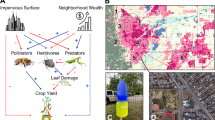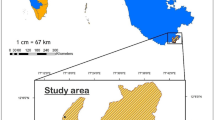Abstract
Eastern grey squirrels (Sciurus carolinensis) and North American red squirrels (Tamiasciurus hudsonicus) were studied among wooded patches within an agricultural mosaic. Fifteen sites south of Ottawa, Canada, with differing landscape and local features were censused using tracking boards placed in a woods or wooded fencerow. Regression analyses of landscape compositional and physiognomic variables within a 1-km radius isolated the best predictors of grey and red squirrel abundance and activity. Grey squirrels were found in both small woods and fencerows in farm landscapes but were not found in large woods. A polynomial regression of wooded patch size explained 79% of the variance in grey squirrel abundance. Grey squirrel activity was correlated with the percent cover of soybeans in the landscape. Red squirrels were found in fencerows, small and large woods; activity was correlated with the percent cover of both woods and corn crop in the surrounding landscape. These results indicate that distributions of both species are influenced by multiple landscape elements, but that grey squirrels may rely on fragmented agricultural landscapes whereas red squirrels make more use of both native woodland and altered landscapes.
Similar content being viewed by others
References
Andren, H. 1994. Effects of habitat fragmentation on birds and mammals in landscapes with different proportions of suitable habitat: a review. Oikos 71: 355–366.
Andren, H. and Delin, A. 1994. Habitat selection in the Eurasian red squirrel, Sciurus vulgaris, in relation to forest fragmentation. Oikos 70: 43–48.
Bennett, A., K. Henein, and G. Merriam. 1994. Corridor use and the elements of corridor quality-chipmunks and fencerows in a farmland mosaic. Biol Cons 68: 155–165.
Bright, P. W. 1993. Habitat fragmentation–problems and predictions for British mammals. Mammal Rev 23 (3/4): 101–111.
Carroll, C. 1992. Ecological management of sensitive natural areas. In Conservation Biology: The Theory and Practice of Nature Conservation, Preservation and Management. Edited by P. Fiedler and S. Jain. Chapman and Hall, London, pp. 347–372.
Celada, C., Bogliani, G., Gariboldi, A. and Maracci, A. 1993. Occupancy of isolated woodlots by the red squirrel Sciurus vulgaris L. in Italy. Biol Cons 69: 177–183.
Dobbyn, J. 1994. Atlas of the Mammals of Ontario. Federation of Ontario Naturalists, Don Mills, Ontario.
Dunning, J. B., Danielson, B. J. and Pulliam, H. R. 1992. Ecological processes that affect populations in complex landscapes. Oikos 65: 169–175.
Gurnell, J. 1983. Squirrel numbers and the abundance of tree seed. Mammal Rev 13 (2/3/4): 133–148.
Gurnell, J. 1984. Home range, territoriality, caching behaviour and food supply of the red squirrel (Tamiasciurus hudsonicus fremonti) in a subalpine lodgepole forest. Animal Behav 32: 1119–1131.
Gurnell, J. 1987. The Natural History of Squirrels. Christopher Helm, London.
Henderson, M. T., Merriam, G. and Wegner, J. 1985. Patchy environments and species survival: chipmunks in an agricultural mosaic. Biol Cons 31: 95–105.
Henein, K. 1995. Predicting the survival of woodland species in human-altered landscapes. Ph.D. Thesis, Carleton University, Ottawa.
Hurlbert, S. H. 1984. Pseudoreplication and the design of ecological field experiments. Ecol Monogr 54 (2): 187–211.
Koprowski, J. 1991. Response of fox squirrels and gray squirrels to a late spring-early summer food shortage. J Mammalogy 72 (2): 267–372.
Kotliar, N. B. and Wiens, J. A. 1990. Multiple scales of patchiness and patch structure: a hierarchical framework for the study of heterogeneity. Oikos 59: 253–260.
Kozakiewicz, M. 1993. Habitat isolation and ecological barriers–the effect on small mammal populations and communities. Acta Theriologica 38 (1): 1–30.
Merriam, G. 1991. Corridors and connectivity: animal populations in heterogeneous environments. In Nature Conservation 2: The Role of Corridors. pp. 133–142. Edited by D. A. Saunders and R. J. Hobbs. Surrey Beatty and Sons Pty Ltd, Chipping Norton, NSW, Australia.
Middleton, J. and Merriam, G. 1983. Distribution of woodland species in farmland woods. J Appl Ecol 20: 625–644.
Ogren, W. L. and Rinne, R. W. 1973. Photosynthesis and Seed Metabolism. In Soybeans: Improvement, Production and Uses. pp. 391–416. Edited by B. E. Caldwell. American Society of Agronomy Inc., Madison, Wisconsin.
Pedlar, J. H. 1995. Variation in raccoon and skunk abundance along an agricultural intensity gradient across two spatial scales. M.Sc. Thesis, Carleton University, Ottawa.
Peterson, R. L. 1957. Changes in the mammalian fauna of Ontario. In Changes in the Fauna of Ontario. pp. 43–58. Edited by F. A. Urquhart. University of Toronto Press, Toronto.
Riege, D. A. 1991. Habitat specialization and social factors in distribution of red and grey squirrels. J Mammalogy 72 (1): 152–162.
SAS Institute. 1990. SAS/STAT Users Guide, Version 6, Fourth Edition. SAS Institute Inc., Cary, NC.
Smallwood, P. D. and Peters, W.D. 1986. Grey squirrel food preferences: the effects of tannin and fat concentration. Ecology 67 (1): 168–174.
Szacki, J., Babinska-Werka, J. and Liro, A. 1993. The influence of landscape spatial structure on small mammal movements. Acta Theriologica 38 (2): 113–123.
Tapper, S. C. and Barnes, R. F. W. 1986. Influence of farming practice on the ecology of the brown hare (Lepus europaeus). J Appl Ecol 23: 39–52.
Taylor, P. D., Fahrig, L. Henein, K. and Merriam, G. 1993. Connectivity is a vital element of landscape structure. Oikos 68: 571–573.
van Apeldoorn, R., El Daem, M., Hawley, K., Kozakiewicz, M., Merriam, G., Nieuwenhuizen, W. and Wegner, J. 1993. Footprints of small mammals–a field method of sampling data for different species. Mammalia 57 (3): 407–424.
van Apeldoorn, R., Celada, C. and Nieuwenhuizen, W. 1994. Distribution and dynamics of the red squirrel (Sciurus vulgaris L.) in a landscape with fragmented habitat. Landscape Ecol. 9 (3): 227–235.
Verboom, B. and van Apeldoorn, R. 1990. Effects of habitat fragmentation on the red squirrel, Sciurus vulgaris L. Landscape Ecol 4 (2/3): 171–176.
Wauters, L., Casale, P. and Dhondt, A. 1994. Space use and dispersal of red squirrels in fragmented habitats. Oikos 69: 140–146.
Wegner, J. 1995. Habitat distribution, spatial dynamics and reproduction of a forest rodent (Peromyscus leucopus) in an agricultural landscape. Ph.D. Thesis, Carleton University, Ottawa.
Wegner, J. and Merriam, G. 1990. Use of spatial elements in a farmland mosaic by a woodland rodent. Biol Cons 54: 263–267.
Author information
Authors and Affiliations
Rights and permissions
About this article
Cite this article
Fisher, J.T., Merriam, G. Resource patch array use by two squirrel species in an agricultural landscape. Landscape Ecology 15, 333–338 (2000). https://doi.org/10.1023/A:1008137506634
Issue Date:
DOI: https://doi.org/10.1023/A:1008137506634




